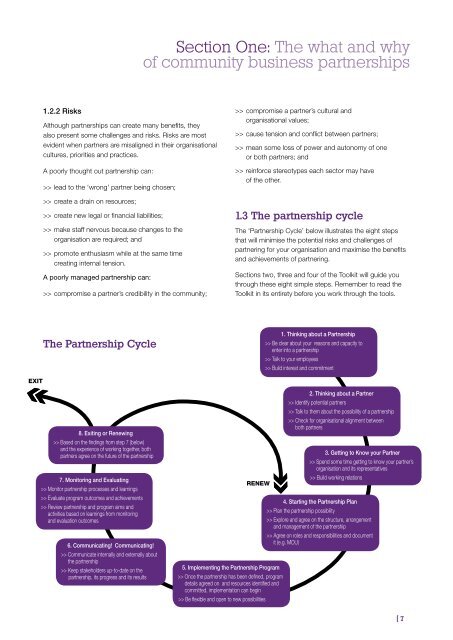partnering with community organisations - Department of Families ...
partnering with community organisations - Department of Families ...
partnering with community organisations - Department of Families ...
Create successful ePaper yourself
Turn your PDF publications into a flip-book with our unique Google optimized e-Paper software.
Section One: The what and why<br />
<strong>of</strong> <strong>community</strong> business partnerships<br />
1.2.2 Risks<br />
Although partnerships can create many benefits, they<br />
also present some challenges and risks. Risks are most<br />
evident when partners are misaligned in their organisational<br />
cultures, priorities and practices.<br />
A poorly thought out partnership can:<br />
>> lead to the ‘wrong’ partner being chosen;<br />
>> create a drain on resources;<br />
>> create new legal or financial liabilities;<br />
>> make staff nervous because changes to the<br />
organisation are required; and<br />
>> promote enthusiasm while at the same time<br />
creating internal tension.<br />
A poorly managed partnership can:<br />
>> compromise a partner’s credibility in the <strong>community</strong>;<br />
>> compromise a partner’s cultural and<br />
organisational values;<br />
>> cause tension and conflict between partners;<br />
>> mean some loss <strong>of</strong> power and autonomy <strong>of</strong> one<br />
or both partners; and<br />
>> reinforce stereotypes each sector may have<br />
<strong>of</strong> the other.<br />
1.3 The partnership cycle<br />
The ‘Partnership Cycle’ below illustrates the eight steps<br />
that will minimise the potential risks and challenges <strong>of</strong><br />
<strong>partnering</strong> for your organisation and maximise the benefits<br />
and achievements <strong>of</strong> <strong>partnering</strong>.<br />
Sections two, three and four <strong>of</strong> the Toolkit will guide you<br />
through these eight simple steps. Remember to read the<br />
Toolkit in its entirety before you work through the tools.<br />
The Partnership Cycle<br />
1. Thinking about a Partnership<br />
>> Be clear about your reasons and capacity to<br />
enter into a partnership<br />
>> Talk to your employees<br />
>> Build interest and commitment<br />
EXIT<br />
8. Exiting or Renewing<br />
>> Based on the findings from step 7 (below)<br />
and the experience <strong>of</strong> working together, both<br />
partners agree on the future <strong>of</strong> the partnership<br />
7. Monitoring and Evaluating<br />
>> Monitor partnership processes and learnings<br />
>> Evaluate program outcomes and achievements<br />
>> Review partnership and program aims and<br />
activities based on learnings from monitoring<br />
and evaluation outcomes<br />
6. Communicating! Communicating!<br />
>> Communicate internally and externally about<br />
the partnership<br />
>> Keep stakeholders up-to-date on the<br />
partnership, its progress and its results<br />
RENEW<br />
5. Implementing the Partnership Program<br />
>> Once the partnership has been defined, program<br />
details agreed on and resources identified and<br />
committed, implementation can begin<br />
>> Be flexible and open to new possibilities<br />
2. Thinking about a Partner<br />
>> Identify potential partners<br />
>> Talk to them about the possibility <strong>of</strong> a partnership<br />
>> Check for organisational alignment between<br />
both partners<br />
3. Getting to Know your Partner<br />
>> Spend some time getting to know your partner’s<br />
organisation and its representatives<br />
>> Build working relations<br />
4. Starting the Partnership Plan<br />
>> Plan the partnership possibility<br />
>> Explore and agree on the structure, arrangement<br />
and management <strong>of</strong> the partnership<br />
>> Agree on roles and responsibilities and document<br />
it (e.g. MOU)<br />
[ 7




![pdf [107kB] - Department of Families, Housing, Community Services](https://img.yumpu.com/51272499/1/190x245/pdf-107kb-department-of-families-housing-community-services.jpg?quality=85)










![Land Claim - pdf [278kB] - Department of Families, Housing ...](https://img.yumpu.com/47002639/1/184x260/land-claim-pdf-278kb-department-of-families-housing-.jpg?quality=85)

![Borroloola Land Claim - pdf [299kB] - Department of Families ...](https://img.yumpu.com/46103973/1/184x260/borroloola-land-claim-pdf-299kb-department-of-families-.jpg?quality=85)